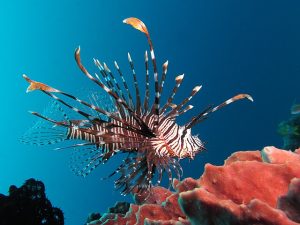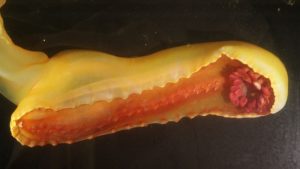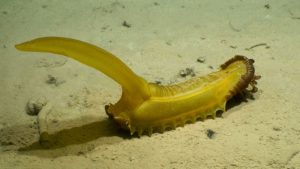Strange Animals Podcast

Episode 411: Lionfish and Sea Squirrel
Thanks to David and Jayson for their suggestions this week!
Further reading:
Unveiling the lionfish invasion in the Mediterranean Sea
DeepCCZ: The Weird and Wonderful Megafauna of the Abyssal CCZ
The red lionfish is beautiful but does not look like a lion [photo by Alexander Vasenin – Own work, CC BY-SA 3.0, https://commons.wikimedia.org/w/index.php?curid=25523559]:

The sea squirrel is yellow above and red underneath (pictures from article linked above):

Under side of a gummy squirrel photographed on shipboard showing its bright red feeding palps (flower-like structure) and underbelly.

Gummy squirrel (“Psychropotes longicauda”) at 5100 m depth on abyssal sediments in the western CCZ. This animal is ~60 cm long (including tail), with red feeding palps (or “lips”) visibly extended from its anterior end (right).
Show transcript:
Welcome to Strange Animals Podcast. I’m your host, Kate Shaw.
This week we’re going to learn about two interesting marine animals suggested by Jayson and David.
Let’s start with David’s suggestion, the lionfish. The lionfish doesn’t actually look like a lion although it is a fish. It lives in shallow tropical water in the Indian Ocean and western Pacific, especially around coral reefs.
There are twelve species of lionfish known, but they’re mostly fairly similar. The lionfish is brown or dark red in color with white stripes, fan-like fins, and lots of long spines, all of which are striped black and white or red and white to make them more visible. When a fish or other animal has markings that make it stand out against the background, you can be pretty sure that it’s dangerous, and that’s the case for the lionfish.
The lionfish’s spines are venomous, especially the spines on the dorsal fin. If it feels threatened, it will point the dorsal fin at the predator and keep it pointed at it no matter which direction the predator moves. If the predator swims below the lionfish, the lionfish will turn upside-down in the water to keep the dorsal fin pointed at it. Most predators back off at that point, and I don’t blame them because that sounds really scary.
People have died from lionfish venom, but it’s rare. Mostly it’s just extremely painful and makes the person feel really sick for a day or two. Divers have to be careful when they’re around lionfish, because lionfish can be aggressive and will point that dorsal fin at the diver as a warning. You don’t want a lionfish to point at you.
The lionfish eats smaller fish, including smaller lionfish, invertebrates, and other small animals. It confuses other fish by blowing water at them. The little fish turns to face into what it thinks is a weird water current, and suddenly, there’s a lionfish that just gulps it down.
As David points out, even though the lionfish is dangerous, it’s definitely beautiful. Some people keep lionfish in saltwater aquariums, although they’re hard to care for in captivity, and unfortunately sometimes the fish escape into the wild or are released. The red lionfish is especially invasive in the Caribbean Sea, the Gulf Coast, and off the southeastern coast of the United States. Lionfish have also been introduced to parts of the Mediterranean Sea, where they’re becoming more and more invasive.
Because invasive lionfish eat so many native fish, and because it’s spreading rapidly and becoming extremely common, people have been trying to find ways to reduce the invasive population. It turns out that lionfish are good to eat if you’re careful when handling the spines during cleaning, so people in areas where it’s invasive are encouraged to catch lionfish to eat. Invasive lionfish are even served in fancy restaurants. Since the red lionfish can grow around 18 inches long, or 47 cm, there’s lot a of meat on one.
No one’s sure why it’s called a lionfish. It doesn’t look remotely like a lion. It’s also called the zebrafish because of its stripes.
Next, Jayson wants to learn about the sea squirrel. Despite its name, it is not a squirrel, although it does live in the sea. It’s a type of sea cucumber that lives mostly in the Atlantic and the northeastern Pacific, but it’s also a deep-sea animal so you’re not likely to see it on your next trip to the beach. It’s yellow on top and red underneath, with 18 red feeding palps. These palps look like little flower petals surrounding its mouth, which is underneath the body. Its body is flattened on the bottom like a slug’s, but it has tiny tube feet that it uses to move around slowly.
None of this sounds like a squirrel, but that’s because I forgot to mention the rear appendage, which sticks up and back and is shaped sort of like a squirrel tail. Since the sea squirrel’s body is long and slender, it does resemble a squirrel in shape very slightly.
The sea squirrel is actually quite large. If you count the “tail,” it can measure almost 3 feet long, or 80 cm. It lives on the sea floor, where it eats whatever tiny food it can find that has sunk down from above.
The deep ocean floor mostly doesn’t have strong currents, and scientists think that’s why the sea squirrel has a tail. It’s not actually a tail, it’s a sail—or at least, that’s what we think it is. Larval sea squirrels have an appendage that almost definitely acts as a sail, allowing it to travel to new parts of the ocean without needing to swim. In adults, the tail may catch any small currents in the water, which may move the animal a short distance away. Since the sea squirrel doesn’t walk very quickly and can’t swim at all, and it finds all its food underfoot, getting moved to a new part of the sea floor where it hasn’t already eaten everything is beneficial.
Sometimes people call the sea squirrel the gummy squirrel because it kind of looks like a big piece of gummy candy, but it’s probably not a good idea to eat it. For one thing, scientists think its body may contain toxins, since its bright yellowy-green color may act as a warning to potential predators. Since nothing has been found that eats the sea squirrel, the warning must be working.
You can find Strange Animals Podcast at strangeanimalspodcast.blubrry.net. That’s blueberry without any E’s. If you have questions, comments, or suggestions for future episodes, email us at strangeanimalspodcast@gmail.com. We also have a Patreon at patreon.com/strangeanimalspodcast if you’d like to support us for as little as one dollar a month and get monthly bonus episodes.
Thanks for listening!






 Visit Podcast Website
Visit Podcast Website RSS Podcast Feed
RSS Podcast Feed Subscribe
Subscribe
 Add to MyCast
Add to MyCast